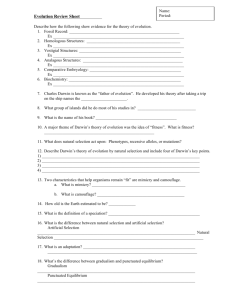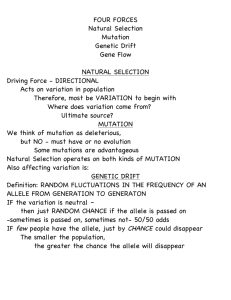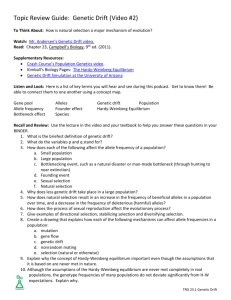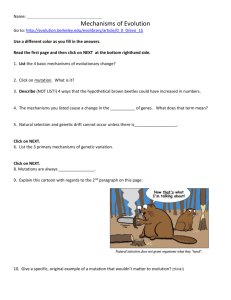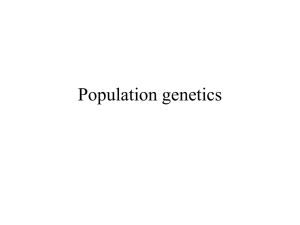lecture 4 genetic drift
advertisement
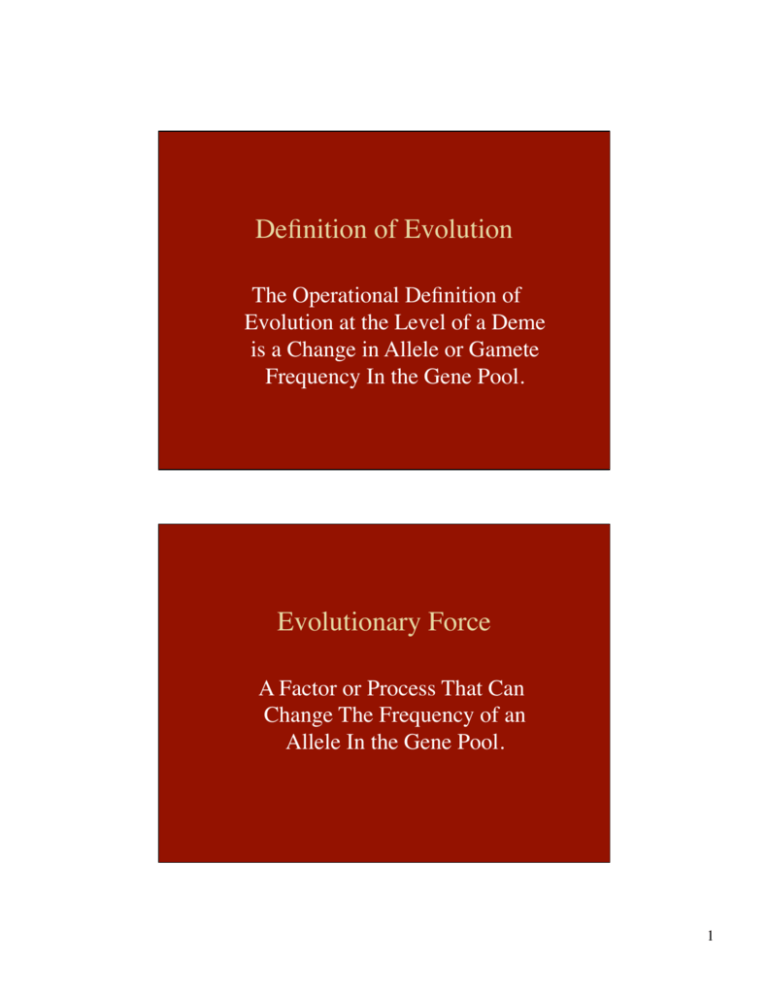
Definition of Evolution
The Operational Definition of
Evolution at the Level of a Deme
is a Change in Allele or Gamete
Frequency In the Gene Pool.
Evolutionary Force
A Factor or Process That Can
Change The Frequency of an
Allele In the Gene Pool.
1
Deme of N Individuals
Gene Pool Before
Mutation
A
p = 1
Mutation
A
p = 1-1/(2N)
a
Gene Pool After
Mutation
q = 1/(2N)
Mutation Is an Evolutionary Force
Genetic Drift
Genetic Drift Occurs When
Sampling Error Alters Allele
Frequencies.
Sampling Error Occurs When
Populations Are Finite in Size.
Therefore, Finite Population Size
is An Evolutionary Force
2
e.g., the two largest samples have ratios closest to 3:1, but still not “perfect”
Mendel’s Ratios Were Not “Perfect” Because
They Are Based On A Finite Number of
Observations.
A Frequency In A Sample Only Converges To the
Probability As The Sample Size Gets Larger and
Larger.
A Deme Is A Collection of Such
Crosses, Each Subject to Random
Sampling Error in Its Mendelian
Ratios
3
Computer Simulation of Genetic Drift
Gene Pool
A
1/
2
a
1/
2
Number of Occurrences in
Simulation
Sample 10 Gametes to
Create 5 Individuals
Do This 20 Times To Show
Sampling Variation
6
5
4
3
2
1
0
0
1
2
3
4
5
6
7
8
9
10
(0.0) (0.1) (0.2) (0.3) (0.4) (0.5) (0.6) (0.7) (0.8) (0.9) (1.0)
Number (Frequency) of A Alleles
Property 1 of Genetic Drift: No Direction
Number of Occurrences in
Simulation
A
1/
2
6
a
1/
2
p = 0.5
20 Simulations
of a population
of size = 5
5
4
3
2
1
0
0
1
2
3
4
5
6
7
8
9
10
(0.0) (0.1) (0.2) (0.3) (0.4) (0.5) (0.6) (0.7) (0.8) (0.9) (1.0)
Number (Frequency) of A Alleles
4
Property 2 of Genetic Drift: It Is Cumulative
A
a
1/
2
1/
2
Number of Occurrences
in Simulation
10 Gametes
6
5
4
3
2
1
0
0
1
2
3
4
5
6
7
8
9 10
(0.0)(0.1)(0.2)(0.3)(0.4)(0.5)(0.6)(0.7)(0.8)(0.9)(1.0)
Let This Be The Sample That Actually Occurs
Property 2 of Genetic Drift: It Is Cumulative
A
a
1/
2
1/
2
Number of Occurrences
in Simulation
10 Gametes
6
5
4
3
2
1
0
0
1
2
3
4
5
6
7
8
9 10
(0.0)(0.1)(0.2)(0.3)(0.4)(0.5)(0.6)(0.7)(0.8)(0.9)(1.0)
Number of
Occurrences in
Simulation
10 Gametes
6
5
4
3
2
1
0
0
1
2
3
4
5
6
7
8
9 10
(0.0)(0.1)(0.2)(0.3)(0.4)(0.5)(0.6)(0.7)(0.8)(0.9)(1.0)
5
Property 2 of Genetic Drift: It Is Cumulative
2N = 10
p
Bigger Deviations From Initial Gene Pool
Become More Likely With Passing Time
Generation
Property 2 of Genetic Drift: It Is Cumulative
Simulations of N = 50, p = 0.5
BottleneckSim[50,50,20,40,.5]
MultiSim[50, 50, 20, 40, .5]
6
4
3
2
1
0
0
1
2
3
4
5
6
7
8
9 10
(0.0)(0.1)(0.2)(0.3)(0.4)(0.5)(0.6)(0.7)(0.8)(0.9)(1.0)
6
5
4
3
2
20 (1.0)
18 (0.9)
16 (0.8)
14 (0.7)
12 (0.6)
8 (0.4)
10 (0.5)
0
6 (0.3)
1
4 (0.2)
20
Gametes
5
2 (0.1)
a
1/
2
6
0 (0.0)
A
1/
2
Number of Occurrences in
Simulation
Gene Pool
10
Gametes
Number of Occurrences
in Simulation
Property 3 of Genetic Drift: Strength α 1/2N
Number (Frequency) of A Alleles
Property 3 of Genetic Drift: Strength α 1/2N
Simulations of p=0.5 with N=25, 100 and 1000
MultiSim[N, N, 20, 40, .5]
7
Property 4 of Genetic Drift: Loss of Alleles
A
a
1/
2
1/
2
Number of Occurrences
in Simulation
10 Gametes
6
5
4
3
2
1
0
0
1
2
3
4
5
6
7
8
9 10
(0.0)(0.1)(0.2)(0.3)(0.4)(0.5)(0.6)(0.7)(0.8)(0.9)(1.0)
10 Gametes
Number of
Occurrences in
Simulation
6
5
4
3
2
1
0
0
1
2
3
4
5
6
7
8
9 10
(0.0)(0.1)(0.2)(0.3)(0.4)(0.5)(0.6)(0.7)(0.8)(0.9)(1.0)
Properties 3 & 4 of Genetic Drift: Rate of Loss of Alleles
Rate of Loss = 1/2N
8
Properties 3 & 4 of Genetic Drift: Loss of Alleles =
Ultimate Fixation If Have No Mutation
DriftSim[N, .5]
Property 5 of Genetic Drift: Isolated Demes
Become Genetically Differentiated (From Property 1)
2N = 20
p
4 Isolated Demes Started
From One Ancestral
Deme With p = 0.5
Generation
9
Property 6 of Genetic Drift: Random Changes In
Multi-locus Gamete Frequencies Create Linkage
Disequilibrium
0.9
0.8
0.7
0.6
0.5
0.4
0.3
0.2
0.1
0
5
10
20
40
80
Distance
Utah
Swed
160
S
U
(kb)
AllYor
YorBot
YorTop
Properties of Genetic Drift
1.
2.
3.
4.
Has No Direction
Is Cumulative
Strength is Proportional to 1/2N
Leads to Loss (and Fixation and Coalescence) of
Alleles Within Demes
5. Leads to Genetic Differentiation Between
Isolated Demes
6. Creates |D| > 0
10
Although Strength of Genetic Drift is
Proportional to 1/2N, Drift Can be
Important in Large Populations
1.
2.
3.
4.
Founder Effects -- A Large Population Today Was
Founded By A Small Number of Founders in the Past.
Bottleneck Effects -- A Large Population Today
Underwent One or More Generations of Small Size in the
Past.
Coalescence – all copies of a gene ultimately coalesce to
a common ancestral allele due to drift in all populations.
Neutral Alleles -- Alleles With No Impact on Any
Phenotype Related to Reproductive Success. Their Fate
is Determined by Drift and Mutation.
Although Strength of Genetic Drift is
Proportional to 1/2N, Drift Can be
Important in Large Populations
1. Founder Effects -- A Large Population Today
Was Founded By A Small Number of Founders
in the Past.
2. Bottleneck Effects -- A Large Population Today
Underwent One or More Generations of Small
Size in the Past.
MultiSim[500, 2, 20, 40, .5]
11
A Human Founder Event
• The Population of the Mountain Village of Salinas
in the Dominican Republic Was 4,300 in 1974.
• The Village Was Founded By A Handful of
People 7 Generations Before
• One Founder, Altagracia Carrasco, Had Many
Children by Four Women
• The Alleles Carried by Him Were Therefore in
High Frequency in the Founder Population Gene
Pool
• Subsequent Population Growth Reduced the Force
of Drift But “Freezes In” The Allele Frequencies
Created by the Initial Founder Event So His
Alleles Remain In High Frequency Even Today
Altagracia Carrasco, Like Most
People, Was A Heterozygous
Carrier For an Autosomal
Recessive Genetic Disease:
5-α Steroid Reductase Deficiency
5-α Steroid Reductase
testosterone
dihydrotestosterone
12
Under The Control of
Testosterone
Default
Pathway in
All
Mammals
Under The
Control of
Dihydrotestosterone
Linkage Disequibrium Is Created By Population
Subdivision In A Manner Not Related To Recombination
(Creates Serious Problems For Disequilibrium Mapping)
Gene Pool for Population 1
Gene Pool for Population 2
gAB=1
gab=1
D=0
D=0
Gene Pool for Pooled Populations
gAB=1/2
gab=1/2
D=gABgab=1/4, D’=1
13
Problem!
Population Structure or Historical Isolates Can Create
Spurious Phenotypic Associations. E.g., in Quebec there are
French and English Speaking Canadians. French Canadians
Have Been Strongly Influenced by a Past Founder Event and
Show Allele Frequency Differences At Many Loci From the
English Population. Therefore, A Mapping Study of the
“Quebec” Population Would Reveal A Strong Association
Between Many Loci and the Language One Spoke.
Similarly, A Candidate Locus Study Would Find An
Association With Language If The Candidate Locus Showed
Haplotype Frequency Differences Between English and
French Canadians.
Avoiding Problem of Hidden
Population Structure
1. Use founder or bottleneck populations (but must
make sure they truly are and have been highly
isolated since the drift event)
2. Use several loci to reconstruct recent
evolutionary history and population structure prior
to initiating association study, and then choose
populations accordingly or use as a control set of
loci in the association study.
14
Founder & Bottleneck Events
• Can Drastically Alter Allele Frequencies, Including
Making Certain Genetic Disease Allele or Disease Risk
Alleles Common (makes obtaining pedigrees for linkage
mapping much easier)
• Leads to pedigree inbreeding (Speke’s gazelles; humans
on Tristan da Cunha)
• Creates Linkage Disequilibrium, Which Rarely Extends
Over 1 cM in Large Demes (makes disequilibrium
mapping much easier)
• Reduce Overall Genetic Variation, Creating A Simpler
Genetic Background
• For The Above Reasons, Such Populations Are
Important In Biomedical Research & Conservation
E.g., Positional Cloning & QTL’s
• The First Case of Positional Cloning Was
the Gene for Huntington’s Chorea
• Nancy Wexler Realized That The Key Was
to Find a Founder Population With A High
Frequency of HD.
• She Found Such A Population On Lake
Maracaibo
• Now, Founder Populations Such As This
Are Regarded As Commercially Valuable
Assets.
15
E.g., Positional Cloning & QTL’s
About 200 years ago, a single woman who happened to carry the
Huntington's allele bore 10 children — and today, many
residents of Lake Maracaibo trace their ancestry (and their
disease-causing gene) back to this lineage.
Effective Population Size
• Founder And Bottleneck Events Show That
The Current Size Of A Population May Not
Be A Good Indicator Of The Impact Of
Genetic Drift Upon That Population
• The Concept of EFFECTIVE
POPULATION SIZE Solves This Problem.
16
Effective Population Size
measures the strength of genetic drift
in influencing some population
genetic feature of interest relative to
how that same feature evolves
through genetic drift in an idealized
population over the same number of
generations
The Idealized Reference Population
• a diploid population of hermaphroditic, self-compatible
organisms
• constant size of N breeding Adults
• random mating
• complete genetic isolation (no contact with any other
population)
• discrete generations with no age structure
• all individuals contribute the same number of gametes on
the average to the next generation (no natural selection)
• the sampling variation in the number of gametes
contributed to the next generation by an individual is given
by a Poisson probability distribution.
17
The Most Common Parameters Used
To Monitor Genetic Drift are:
0.05
0.35
0.30
0.20
0.15
0.10
0.05
0.00
Males
Tristan da Cunha
0.04
• The Average Level
of Identity by
Descent (inbreeding
effective size)
0.25
0.03
0.02
0.01
0.00
1820
1830
1840
1850
1860
1870
1880 1890
1900
1910
1920
1930
1940
1950
Decade of Birth
Females
Animal ID
5
4
3
2
9 (0.9)
10 (1.0)
8 (0.8)
7 (0.7)
6 (0.6)
5 (0.5)
4 (0.4)
3 (0.3)
Generation
2 (0.2)
0
1 (0.1)
1
0 (0.0)
p
6
Number of Occurrences in
Simulation
• The Variance In
Allele Frequency
Induced By Genetic
Drift (variance
effective size)
Impact of Drift On Average F In
An Idealized Population
1
F(t) = 2N + (1 )F(t-1)
2N
1
Probability
Average
Probability
The 2
Probability
Gametes Randomly
Of Identity
Draw 2
By Descent From The
Gametes
Same
At generation t
From
The
Individual
Same
Are
Individual
Identical
18
Impact of Drift On Average F In
An Idealized Population
1
F(t) = 2N + (1 )F(t-1)
2N
1
Probability That
Probability Of
Probability Of
Identity By Descent Not Drawing 2 2 Randomly Drawn
Due To Drawing 2 Copies of The Gametes That Are
Copies of The Same Same Gamete Not Copies of The
Same Gamete
Gamete From The From The Same
Same Individual Individual From From The Previous
Generation Are
From The Previous The Previous
Identical
By Descent
Generation
Generation
Due to Earlier Inbreeding
Impact of Drift On Average F In
An Idealized Population
1
F(t) = 2N + (1 )F(t-1)
2N
1
Can Use The Above Equation Recursively To Obtain:
1 t
F(t) = 1- (1 - 2N ) [F(0) = 0]
19
Impact of Drift On Average F In
An Idealized Population
1 t
F(t) = 1- (1 - 2N ) 0.05
If A Real Population Has An Observed
Average F of F(t) After t Generations
From the Reference Generation With
F = 0; Then The Inbreeding Effective
Size Is Given By:
t
1
F(t) = 1- (1 - 2N ) ef
0.03
0.02
0.01
0.00
1820
1830
1840
1850
1860
1870
1880 1890
1900
1910
1920
1930
1940
1950
Decade of Birth
Nef = or
Tristan da Cunha
0.04
1
2{1-[1-F(t)]1/t}
Impact of Drift On Allele Freq.
Variance In An Idealized Population
(
σ2(t) = pq{1- 1 -
1 t
}
2N
)
5
4
3
2
v(t) = pq{1- (1 -
1 t
}
2Nev
)
or
9 (0.9)
10 (1.0)
8 (0.8)
7 (0.7)
6 (0.6)
5 (0.5)
4 (0.4)
3 (0.3)
2 (0.2)
0
1 (0.1)
1
0 (0.0)
Number of Occurrences in
Simulation
6
If A Real Population Has An Observed
Variance of v(t) After t Generations
From the Reference Generation; Then
The Variance Effective Size Is Given By:
1
Nev = 2{1-[1-v(t)/(pq)]1/t}
20
There Is No Such Thing As The
Effective Size of a Population
• The effective size depends upon which
genetic parameter you are using
• The effective size depends upon which
reference generation you are using
• Therefore, a single population can have
many different effective sizes associated
with it, all biologically meaningful but
distinct
Example: Speke’s Gazelle
• Herd Started in 1969 With 4 Animals
• By 1979 There Were 19 Animals With An Average F of
0.1283 After 1.7 Generations
• Therefore, Nef Relative to the Founders is 6.4 < 19
(Founder Effect)
• In 1979, Management Was Changed, and 15 New Animals
Bred with F = 0.149 and t = 2.7, yielding Nef = 8.6 < 15
(Founder Effect & f < 0)
• Using the parents of the 19 Animals in 1979 as Reference
Generation, then F = 0.0207 and t = 2, yielding Nef = 96.1
> 15 (Effect of Avoidance of Inbreeding in System of
Mating Sense)
21
Example: Speke’s Gazelle
• Herd Started in 1969 With 4 Animals
• In 1979, Management Was Changed, and 15 New Animals
Bred with v/(pq) = 0.135 and t = 2.7 (computer simulation
of exact pedigree), yielding Nev = 9.6 < 15 (Founder
Effect)
• The same 15 animals have
– Nev = 9.6 < 15 (relative to founder generation)
– Nef = 8.6 < 15 (relative to founder generation)
– Nef = 96.1 > 15 (relative to the management change generation)
• WHAT IS THE EFFECTIVE SIZE OF THIS
POPULATION?
In Most Cases, Do Not Have Complete
Pedigree Information, Precluding the
Calculation of Various Effective Sizes.
Many Formulae Have Been Derived as
Estimators or Approximations to
Effective Size.
The Literature Is A Mess, Because
Many Do Not Distinguish Among The
Various Effective Sizes, and Often Mix
Inappropriate Formulae
22
Interactions of System of Mating
with Genetic Drift via Effective Size
• The ideal reference population assumes random mating.
• Suppose mating is non-random, either due to inbreeding or assortative
mating such that f > 0.
• Then:
1 ⎞
⎡ 1 ⎛
⎤
F(t) = f + (1 − f ) ⎢
+ ⎜1 −
F(t
−
1)
⎟
⎥
⎣ 2N ⎝ 2N ⎠
⎦
I by D created
by system of
mating beyond
random mating
expectations.
I by D created by genetic drift at
random mating expectations.
Interactions of System of Mating
with Genetic Drift via Effective Size
t
⎡
⎤
⎛
⎞
1
F (t) = 1− ⎢(1− f )⎜1−
⎟⎥
⎝ 2N ⎠⎦
⎣
N
N ef =
1+ f (2N − 1)
23
Interactions of System of Mating
with Genetic Drift via Effective Size
• Suppose mating is non-random, either due to inbreeding or assortative
mating such that f > 0.
• Then:
Variance in Allele Frequency = (1 - f )
variance created by genetic drift at
random mating expectations.
pq
pq pq(1+ f )
+f
=
2N
N
2N
variance created
by system of
mating beyond
random mating
expectations.
Interactions of System of Mating
with Genetic Drift via Effective Size
• The ideal reference population assumes random mating.
N
N ev =
1+ f
24
Interactions of System of Mating
with Genetic Drift via Effective Size
f=0.1
Ne v
Nef
Population Size N
Interactions of Population Growth
with Genetic Drift via Effective Size
N ef =
2N −1
k −1+ (1− 2Nk )
N ev = N
Where N is an idealized population in every way except
that each individual has an average of k offspring (k=2
corresponds to a constant sized population)
25
Interactions of Population Growth
with Genetic Drift via Effective Size
Effective Sizes in African Rhinos
(Braude and Templeton, African J. Ecol. 47: 546-555, 2009)
Census
Size, 1997
Black Rhinoceros
Inbreeding
Variance
Effective Size Effective Size
N=2,600
Nef =18,840
Nev =4,189
N=8,440
Nef =106
Nev =240
N=23
Nef =69
Nev =41
Diceros bicornis
Southern White Rhinoceros
Ceratotherium simum simum
Northern White Rhinoceros
Ceratotherium simum cottoni
26



